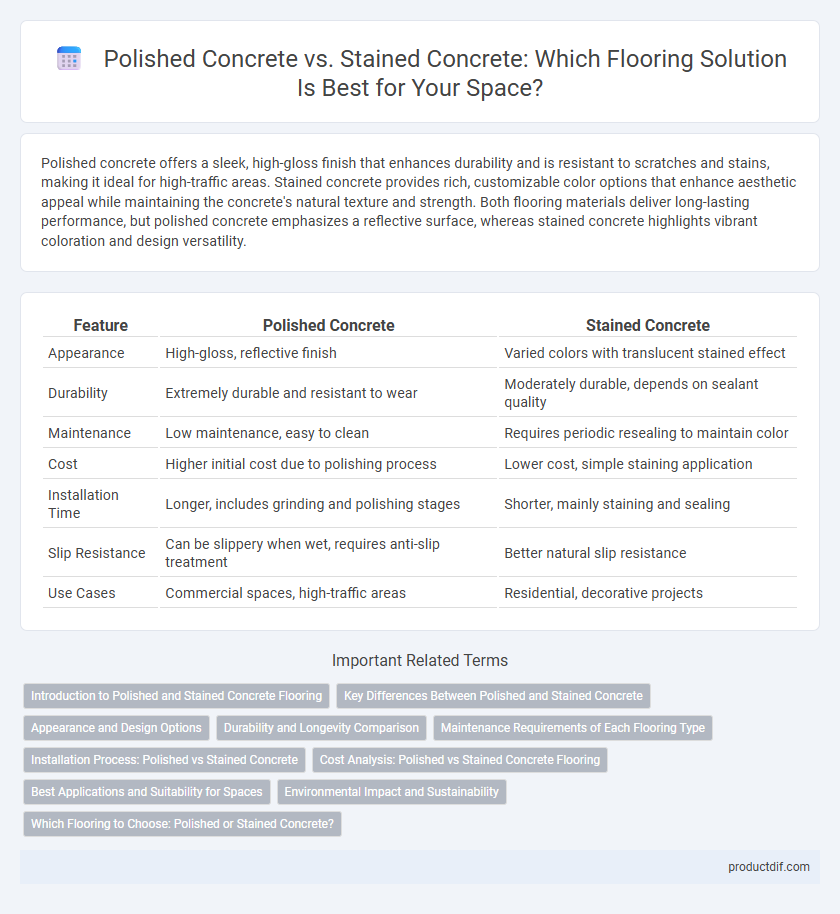Polished concrete offers a sleek, high-gloss finish that enhances durability and is resistant to scratches and stains, making it ideal for high-traffic areas. Stained concrete provides rich, customizable color options that enhance aesthetic appeal while maintaining the concrete's natural texture and strength. Both flooring materials deliver long-lasting performance, but polished concrete emphasizes a reflective surface, whereas stained concrete highlights vibrant coloration and design versatility.
Table of Comparison
| Feature | Polished Concrete | Stained Concrete |
|---|---|---|
| Appearance | High-gloss, reflective finish | Varied colors with translucent stained effect |
| Durability | Extremely durable and resistant to wear | Moderately durable, depends on sealant quality |
| Maintenance | Low maintenance, easy to clean | Requires periodic resealing to maintain color |
| Cost | Higher initial cost due to polishing process | Lower cost, simple staining application |
| Installation Time | Longer, includes grinding and polishing stages | Shorter, mainly staining and sealing |
| Slip Resistance | Can be slippery when wet, requires anti-slip treatment | Better natural slip resistance |
| Use Cases | Commercial spaces, high-traffic areas | Residential, decorative projects |
Introduction to Polished and Stained Concrete Flooring
Polished concrete flooring offers a durable, low-maintenance surface achieved by grinding and polishing concrete slabs to a high-gloss finish, enhancing both strength and aesthetic appeal. Stained concrete involves applying acid or water-based stains that chemically react with the concrete to produce vibrant, translucent colors and unique patterns. Both options provide versatile, cost-effective flooring solutions suitable for residential and commercial spaces seeking modern, industrial-style interiors.
Key Differences Between Polished and Stained Concrete
Polished concrete features a sleek, reflective surface achieved through grinding and buffing, enhancing durability and ease of maintenance, while stained concrete offers vibrant, customizable color options created by applying acidic or water-based stains that penetrate the surface. Polished concrete is ideal for high-traffic areas due to its resistance to wear and abrasion, whereas stained concrete emphasizes aesthetic appeal with its varied hues and patterns but may require additional sealing to protect against stains. Both flooring materials provide cost-effective, low-maintenance solutions but differ significantly in appearance, texture, and long-term performance characteristics.
Appearance and Design Options
Polished concrete offers a sleek, reflective surface with a modern aesthetic, achieved through grinding and buffing to reveal aggregate variations. Stained concrete provides a broader palette with translucent color options that enhance texture and create customizable patterns or designs for a more artistic look. Both flooring materials support durability but differ significantly in their visual impact and design versatility.
Durability and Longevity Comparison
Polished concrete offers superior durability due to its dense, hard surface created by mechanical grinding and chemical hardeners, making it highly resistant to abrasion and heavy foot traffic. Stained concrete, while visually appealing with its vibrant colors and patterns, is more prone to surface wear and may require resealing to maintain its appearance over time. Both options provide long-lasting flooring solutions, but polished concrete generally delivers greater longevity with minimal maintenance.
Maintenance Requirements of Each Flooring Type
Polished concrete requires minimal maintenance, typically involving regular dust mopping and occasional wet cleaning to preserve its glossy finish and prevent surface deterioration. Stained concrete demands more frequent upkeep due to its porous surface, necessitating periodic resealing and gentle cleaning to maintain color vibrancy and prevent staining. Both flooring options offer durable performance, but polished concrete provides a lower maintenance routine compared to stained concrete.
Installation Process: Polished vs Stained Concrete
Polished concrete involves grinding the concrete surface with progressively finer diamond polishing tools to achieve a smooth, glossy finish, often requiring multiple passes and sealant applications. Stained concrete requires surface preparation followed by the application of acid- or water-based stains that penetrate the concrete, creating unique color variations and patterns, with minimal top-layer modification. Polishing demands more intensive mechanical work and time, while staining offers faster installation with customizable aesthetics through chemical reactions.
Cost Analysis: Polished vs Stained Concrete Flooring
Polished concrete typically involves higher upfront costs due to labor-intensive grinding and sealing processes, ranging from $70 to $120 per square yard. Stained concrete offers a more budget-friendly option, averaging $3 to $12 per square foot depending on stain type and surface preparation. Long-term maintenance costs favor polished concrete, which requires less frequent upkeep compared to the periodic resealing often needed for stained concrete.
Best Applications and Suitability for Spaces
Polished concrete offers a sleek, durable surface ideal for high-traffic commercial and industrial spaces where low maintenance is essential. Stained concrete enhances aesthetic appeal with rich color variations, making it suitable for residential areas, retail stores, and decorative flooring projects. Both materials deliver long-lasting performance, but polished concrete excels in durability while stained concrete prioritizes design flexibility.
Environmental Impact and Sustainability
Polished concrete offers a sustainable flooring option by utilizing the existing slab, reducing the need for additional materials and minimizing waste, while its reflective surface enhances natural light, lowering energy consumption. Stained concrete, although also eco-friendly due to its durability and low maintenance, involves chemical treatments that vary in environmental impact depending on the stain type, with water-based stains being more sustainable than acid-based options. Both flooring solutions contribute to reducing the carbon footprint compared to traditional materials, but polished concrete generally has a lower environmental impact due to fewer processing requirements.
Which Flooring to Choose: Polished or Stained Concrete?
Polished concrete offers a durable, low-maintenance surface with a glossy finish that enhances natural light, ideal for high-traffic commercial spaces and modern homes. Stained concrete provides versatile color options and unique, artistic designs by penetrating the concrete surface, making it perfect for decorative aesthetics and personalized interior styles. Choosing between polished and stained concrete depends on balancing durability, maintenance needs, and desired visual impact for your flooring project.
Polished Concrete vs Stained Concrete Infographic

 productdif.com
productdif.com